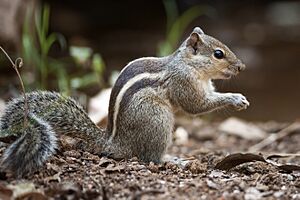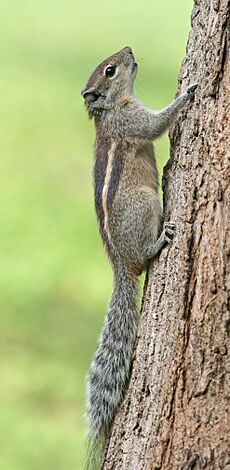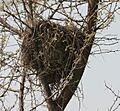Indian palm squirrel facts for kids
Quick facts for kids Indian palm squirrel |
|
|---|---|
 |
|
| Conservation status | |
| Scientific classification | |
| Genus: |
Funambulus
|
| Species: |
palmarum
|
| Subspecies | |
|
|
The Indian palm squirrel or three-striped palm squirrel (Funambulus palmarum) is a small, quick rodent that belongs to the Sciuridae family, which includes squirrels. You can find these squirrels living naturally in India, especially south of the Vindhyas mountains, and in Sri Lanka.
Towards the end of the 1800s, Indian palm squirrels were also brought to other places. These include Madagascar, Réunion, Mayotte, the Comoro Islands, Mauritius, and the Seychelles. There's a close relative called the five-striped palm squirrel (F. pennantii), which lives in northern India. Sometimes, the areas where these two types of squirrels live can overlap.
What They Look Like
The Indian palm squirrel is about the same size as a large chipmunk. It has a bushy tail that is a little shorter than its body. Their fur on their back is a mix of grey and brown. They have three clear white stripes that run all the way from their head to their tail. The two stripes on the outside only go from their front legs to their back legs.
Their belly is a creamy-white color. Their tail has long black and white hairs mixed together. They have small, triangle-shaped ears. Young squirrels are much lighter in color. As they get older, their fur becomes darker. It's very rare, but some of these squirrels can be albino, meaning they have no color in their fur.
Life Cycle
Indian palm squirrels have different ways of reproducing. Some have specific times of the year when they breed, while others can breed all year round.
A mother squirrel is pregnant for about 34 days. They usually build their nests in grassy areas and have their babies during the autumn season. It's common for them to have two or three babies at a time, with an average of about 2.75 babies per litter. The young squirrels stop drinking milk from their mother after about 10 weeks. They are ready to have their own babies when they are about 9 months old. An adult squirrel usually weighs around 100 grams. We don't know much about how long they live in the wild. However, one squirrel lived for 5.5 years while being cared for by humans.
Diet and Behavior
The Indian palm squirrel is mostly a solitary animal. This means they spend most of their lives alone. They only interact with other squirrels when they are mating or raising their young.
Their main diet consists of nuts and fruits. However, they are not picky eaters! Indian palm squirrels will also eat insects, other smaller mammals, and even small reptiles. They are quite noisy and make a sound like "chip chip chip" when they sense danger. In cities, they are very good at finding food. They can also become quite friendly and learn to take food from people's hands. These squirrels are naturally very active. Their activity levels become even more energetic during the mating season. They are also very protective of their food. They will often guard it and chase away birds or other squirrels trying to take it.
Unlike some other types of squirrels, the Indian palm squirrel does not hibernate. This means they stay active all year long, even in colder weather.
Importance in Hinduism
Squirrels are considered special and sacred animals by many Hindus. Because of this, people believe they should not be harmed. Many Hindu families even feed squirrels because of their connection to Rama, a very important figure in Hinduism.
There's a famous legend that explains the stripes on the backs of most squirrels. The story says that during the building of the Rama Setu (a bridge) at Rameswaram, Lord Rama and his monkey army (Vanara Sena) were working hard. A tiny squirrel wanted to help too! It rolled in the beach sand and then ran to the bridge to shake the sand off its back. Lord Rama was very pleased with the squirrel's dedication. He gently stroked the squirrel's back. Ever since that day, Indian squirrels have carried white stripes on their backs. People believe these stripes are the marks left by Rama's fingers. This story about Rama and the squirrel is even mentioned in some ancient hymns.
Images for kids






